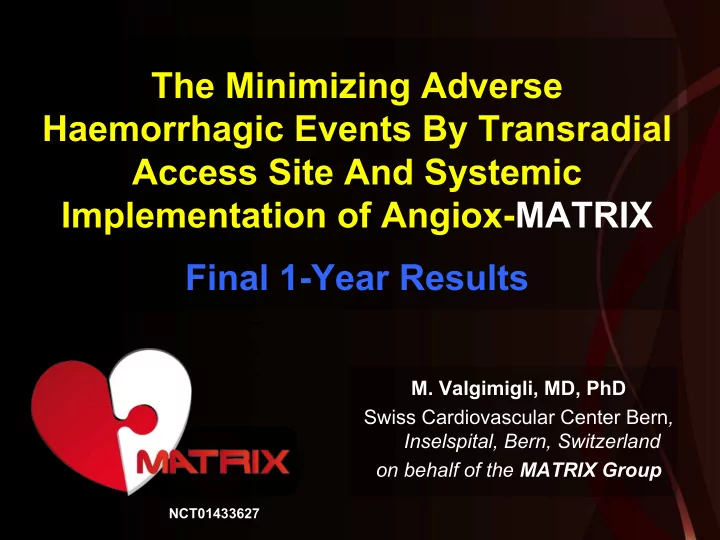

The Minimizing Adverse Haemorrhagic Events By Transradial Access Site And Systemic Implementation of Angiox-MATRIX Final 1-Year Results M. Valgimigli, MD, PhD Swiss Cardiovascular Center Bern , Inselspital, Bern, Switzerland on behalf of the MATRIX Group NCT01433627
Declaration of Interest I, Marco Valgimigli, Served as a speaker, or advisor or consultant for: The Medicines Company and Terumo
Background MATRIX −the largest RCT comparing TRA vs TFA in ACS− reported a 30-day net adverse clinical events (NACE) benefit, driven by mortality and bleeding, in favor of the radial approach It is unknown whether the short-term benefits of radial access are maintained at longer-term follow-up Multiple studies reported on longer-term comparative effectiveness of bivalirudin vs UFH±GPI, but results remain controversial and in none of them access site was randomly allocated No study has so far randomized pts receiving bivalirudin to continue or stop the Tx after PCI
MATRIX Program NCT01433627 NSTEACS or STEMI with invasive management Aspirin+P2Y12 blocker 1:1 1:1 Trans-Radial Trans-Femoral ACCESS Access Access 1:1 1:1 Bivalirudin Heparin ANTITHROMBIN TYPE Mono-Tx ±GPI 1:1 1:1 Stop Prolong≥ 4 hs TREATMENT Infusion infusion DURATION 30-day results avaialble at Lancet. 2015; 385(9986):2465-76 and N Engl J Med 2015; 373: 997–1009
Study Organization and Sites Italian Society of Interventional Cardiology Sponsor Grant suppliers: The Medicines Company and Terumo Principal Investigator: Marco Valgimigli, MD, PhD Study Director: Maria Salomone . MD, PhD 78 Sites across 4 EU countries recruited patients National Coordinating Investigators and CROs Paolo Calabrò, MD, PhD, Italy ; Trial Form Support Arnoud W J van‘t Hof, MD, The Netherlands ; Trial Form Support Manel Sabate’, MD, PhD, Spain; FLS-Research Support Elmir Omerovic, MD, PhD, Sweden; Gothia Forum Clinical Event Statistical Data Mng Committee Committee (CTU) P. Vranckx, Chair P.Jüni, MD, Chair E. Frigoli , S. Leonardi Co-Chair M. Rothenbühler Project Leader P. Tricoci Dik Heg
Endpoints Co-primary outcomes at 30 days for MATRIX Access and MATRIX Antithrombin were: MACE: composite of death, MI and stroke NACE: composite of death, MI, stroke and major bleeding (BARC 3 or 5) The primary outcome at 30 days for MATRIX Treatment Duration was composite of urgent target vessel revascularisation, definite stent thrombosis, or net adverse clinical events ( NACE +) Secondary outcomes included all primary EPs within 1 year and each component of the composite outcomes
Patient disposition, baseline characteristics and drug adherence 8391 8,404 pts included in the (99.8%) Access program Complete 1 96% recieved the allocated Tx year data 7,204 7,213 pts included in the (99.9%) Antithrombin Type Program Complete 1 96% recieved the allocated Tx year data 3,606 3,610 pts included in the (99.9%) Treatment duration Program Complete 1 95% recieved the allocated Tx year data Baseline characteristics were well matched Adherence to secondary prevention medications was similarly high
ACCESS 1-Year Major Adverse CV events Femoral Radial 15.7% 14.2%
ACCESS 1-Year Net Adverse Clinical Events Femoral Radial 17.2% 15.2% NNTB: 50
ACCESS 1 Year NACE Components (CV) Death, MI, Stroke and BARC 3 or 5 Radial Femoral % P=0.99 14 11.6 12 10.7 10 0.84 0.71 0.92 1.00 0.71 8 0.68–1.04 0.54–0.93 0.71–1.05 0.57–1.74 0.54–0.93 P=0.11 P=0.013 P=0.21 P=0.99 P=0.014 6 4.4 3.7 3.3 4 3 2.2 2.2 2 0.6 0.6 0 Death CV Death MI Stroke BARC 3 or 5
ACCESS 1-Year Net Adverse Clinical Events Period Analysis Femoral Radial 17.2% 15.2% NNTB: 50
ANTITHROMBIN 1-Year Major Adverse CV Events UFH Bivalirudin 16.8% 15.8%
ANTITHROMBIN 1-Year Net Adverse Clinical events UFH Bivalirudin 18.4% 17.0%
ANTITHROMBIN 1 Year NACE Components (CV) Death, MI, Stroke and BARC 3 or 5 Bivalirudin UFH % P=0.99 14 12.6 12.4 12 10 0.79 0.74 0.98 0.79 0.68 8 0.63–0.99 0.55–0.99 0.86–1.12 0.44–1.43 0.51–0.91 P=0.042 P=0.043 P=0.77 P=0.44 P=0.008 6 4.6 3.6 4 3 2.9 2.1 2.1 2 0.7 0.6 0 Death CV Death MI Stroke BARC 3 or 5
TREATMENT DURATION 1-Year Net Adverse Clinical Events + Urgent TVR, definite ST, or Net adverse clinical events No post-PCI bivalirudin Post-PCI bivalirudin 17.4%
Post-PCI Bivalirudin Rx Regimens and temporal distribution Bivalirudin could be administered at*: the full PCI dose (1.75mg/kg/h) for up to 4 hours or the reduced dose of 0.25 mg/Kg/h for at least 6 hours *: with the choice between those two regimens made at the discretion of the treating physicians Full PCI regimen 34% Infusion duration: 264 ’ Reduced regimen 59% Infusion duration: 433 ’ N=119 ( 6.6% ) received no post-PCI bivalirudin in the post-PCI bivalirudin arm
TREATMENT DURATION Exploratory Analysis* Efficacy endpoints according to bivalirudin regimen 0.25 Post-PCI Biv 1.75 Post-PCI Biv no Post-PCI Biv 20.3 19.8 % 14.7 20 18.6 17.4 17 15.7 15.6 15 12.1 11.9 11.8 11.3 10 8.5 5 2.2 2.4 2.1 1.3 0.8 0.2 0 MACE NACE NACE + CV Death MI Definite ST * The choice of post-PCI bivalirudin regimen was at discretion of the investigator
MATRIX@1 year: Summary The radial access reduced the 1 year NACE rates, owing to a durable effect on CV death and bleed The use of bivalirudin did not reduce MACE or NACE rates although its effects on mortality and bleeding persisted at 1 year as compared to UFH±GPI Post-PCI bivalirudin infusion did not reduce 1 year NACE+ rates compared to no post-PCI bival. However, the post-PCI low regimen was associated to higher and the full dose to lower ischemic risks at exploratory analysis.
Recommend
More recommend